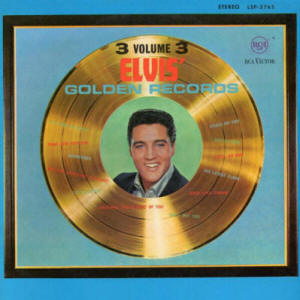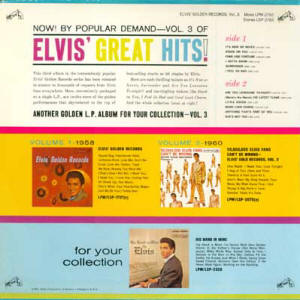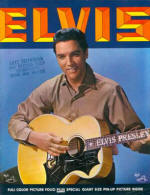Verdict
The songs are great, vocally Elvis is at his best and because all tracks were recorded at the same studio with more or less the same personnel, the album doesn't sound like a compilation at all.
![]()
(C) RCA Victor
The ultimate site about the king of the analogue age


The follow-up to the soundtrack album "It Happened At The World's Fair" wasn't the long-awaited studio album with new songs, but the third installment of "Elvis' Golden Records". It was released in late August 1963, sold 600,000 units during its initial sales period and appeared on Billboard's "Top LPs Chart" on September 24th. "Elvis' Golden Records - Volume 3" had a run of 40 weeks and peaked at number 3. After the king's demise it charted again on September 10, 1977. This time it only reached number 64, but stayed on the hitparade for 23 weeks. The RIAA honored the domestic sales with Gold (1966) and Platinum (1999). Abroad the album also sold well, worldwide RCA Victor was able to retail five million copies. Today this would be 750 million paid streams of the complete album or 7.5 billion paid streams of individual tracks. Considering, that a regular Presley album sold approximately two million copies less, it was a comprehensible decision to leave the new recordings from May in the vaults and release a compilation of the numerous chart toppers instead.
In 2016 the complete Presley catalogue was restored and remastered by Vic Anesini for a boxed set of 60 compact discs called "The Album Collection". Sony Music Entertainment provides the streaming platforms with the same versions of the individual albums (some of them offering bonus tracks), albeit in 24 bit/90 khz flac. That means, if the platform of your choice supports high resolution audio, you can enjoy the tracks in the same quality Sony used to scan and master them. On Spotify, which has a market share of approximately 30% and is the only platform that publishes streaming figures, "Elvis' Golden Records - Volume 3" accumulates 450 million streams and is requested >150,000 times per day. Therefore it belongs to the top10 of the king's most popular original albums.
The cover design was roughly based on the first edition and showed a promo photo for the movie "It Happened At The World's Fair". The backside of the sleeve included liner notes and advertising for the first two volumes of the "Gold" series as well as for the gospel album "His Hand In Mine". The first pressing of "Elvis' Golden Records - Volume 3" also included a photo booklet.

As usual RCA Victor didn't wait for the RIAA to certify the single releases. The where considered to be "golden" as soon as they had sold a million units inside the US. Once again the label didn't just use the hits, but also the b-sides. They simply allocated a million of the sold units to these tracks, if they thought the fans might want to have them on a longplayer. In total the compilation has a running time of 29:42 minutes.
In 2015 Sony's own collector's label Follow That Dream Records released a special edition of "Elvis' Golden Records - Volume 3", which also included various outtakes. For a review, just tap HERE.
It's Now Or Never
In 1898 the Neapolitan singer and musician Eduardo Di Capua wrote "O Sole Mio" ("My Sun") and used the lyrics of the poet Giovanni Capurro. Even though the song became very popular, both parties died without any assets. At the time there were no royalties for writers and so the men sold the song for 25 lira to the publishing company of Ferdinando Bideri. Many years later the heirs of Emanuele Alfredo Mazzucci sued the publisher for royalties, because he had written down the notes of "O Sole Mio". Since they won the lawsuit they receive a whopping 250,000 USD per year. The first known recording of "O Sole Mio" was made in 1901 by Francisco Daddi. Eleven years later Elisabeth Spencer released an English version named "Your Own Dear Kiss". Elvis got to know the song in form of another English edition called "There's No Tomorrow". He wanted to record it, but because the melody by now was in public domain, Aaron Schroeder and Wally Gold wrote new lyrics and legally created a new song, that could be published on its own. Elvis recorded it on April 3, 1960 at RCA Studio B in Nashville/Tennessee. The master is a splice of the takes 4 and 2, on April 5th piano and percussion was added. RCA re-released "It's Now Or Never" on the extended player "Elvis By Request" (1961), on the album "A Legendary Performer - Volume 2" (1976) and the boxed set "Worldwide 50 Gold Records - Volume 1" (1970). A live version can be found on "Elvis In Concert" (1977). The original single was released in June 1960 and became a number on hit. Over the decades it sold 28 million copies (this amount equals 4.2 billion paid streams!) and became the most successful 45 release of the decade.
Stuck On YouThe song was written by Aaron Schroeder and Leslie McFarland and was recorded by Elvis on March 20, 1960 at RCA Studio B in Nashville/Tennessee within just three takes. In the spring of 1960 the single became a number one hit and sold 3.5 million copies. RCA Victor later re-released the track on the boxed set "Worldwide 50 Gold Award Hits - Volume 1" (1970). Compared to his previous recordings the king sounded much different. His voice was softer, had matured and his technique obviously had improved. The brand new Stereo sound only added to these qualities. Elvis himself is said to have disliked "Stuck On You" and calling it "Stuck IN You". I don't know if this is true or not, his performance is nothing but great.
Fame And FortuneThe ballad was also recorded on March 20, 1960 at RCA Studio B in Nashville/Tennessee, but the master had to be spliced of the takes number 14 and 15. It was written by Fred Wise and Ben Weisman, who later also would write a lot of movie songs for Elvis. "Fame And Fortune" displayed the king's growth as a singer even to a larger degree than "Stuck On You". In the 1950s Elvis' performances of ballads were often mediocre. You always know what he wants to do, but he simply lacked the technique to get it right. In 1960 he finally had learned how to use his voice properly and all of a sudden he seemed to know every trick in the book. "Fame And Fortune" is a great song and it's performed very well. It was the b-side of "Stuck On You" and therefore was re-issued on the boxed set "The Other Sides - Worldwide Gold Award Hits Volume 2" (1971).
I Gotta KnowThe uptempo popsong is a cover version, the original was released in 1959 by Cliff Richard. "I Gotta Know" was also recorded on April 3, 1960 at RCA Studio B in Nashville/Tennessee, but this time within two takes. It's a classy song, I especially like the interaction between the king and The Jordanaires. In late 1960 "I Gotta Know" was released on the flipside of the classic "Are You Lonesome Tonight".
SurrenderAfter "It's Now Or Never" turned out to be a sales monster, Doc Pomus and Mort Shuman used the same principle and turned "Torna A Surriento" into "Surrender". Elvis recorded it on October 30, 1960 at RCA Studio B in Nashville/Tennessee. First he taped nine takes of the song, then he produced eight workpart-takes. The master was spliced of take 4 and workpart-take 8. With mediterranean music and dramatic vocals the singer tries to convince a lady to succumb to him. RCA Victor later re-released "Surrender" on the boxed set "Worldwide 50 Gold Award Hits - Volume 1" (1970). The single was released in February 1961, became a number one hit and sold a staggering six million units (this equals 900 million paid streams).
I Feel So BadThe song was written by Chuck Willis, who also released it in 1954. On March 12, 1961 at RCA Studio B in Nashville/Tennessee the king needed just two takes for his cover version, mainly because he copied Willis' performance almost note for note. RCA Victor re-released the track on the boxed set "Worldwide 50 Gold Award Hits - Volume 1" (1970). Even though the king delivers a great performance of this fast blues song, it doesn't meet my taste. Maybe the fans from that period thought in a similar way, because the single "only" peaked at number 5 and sold 2.5 million copies.
Are You Lonesome TonightThe single was released in November 1960, became a number one hit and sold six million copies. It was nominated for a Granny in three categories, but unfortunately didn't win. The song was written by Roy Turk and Lou Handman, the first recording was by Ned Jakobs in 1927. Elvis recorded his version on April 3, 1960 at RCA Studio B in Nashville/Tennessee, the master is a splice of the takes 5 and 2. I like this ballad very much, the king performs it very well and his voice sounds nothing but marvellous. RCA later also released the track on the extended player "Elvis By Request" (1961) and the boxed set "Worldwide 50 Gold Award Hits - Volume 1" (1970). Live performances can be heared on "From Memphis To Vegas / From Vegas To Memphis" (1969), "A Legendary Performer" (1974) and "Elvis In Concert" (1977).
His Latest FlameOn June 25, 1961 Elvis recorded 12 takes at RCA Studio B in Nashville/Tennessee. Finally he selected the 8th attempt for release. A friend tells the narrator of his latest flame, a girl named Marie. Suddenly he realizes, that the lady is his own girlfriend and obviously isn't as faithful as expected. Even though the story is quite sad, the melody is happy and also Elvis' performance doesn't display even the slightest bit of anger or hurt. But that's the charme of "His Latest Flame". In 1971 it was part of the boxed set "The Other Sides - Worldwide Gold Award Hits Volume 2", the single "His Latest Flame" / "Little Sister" was released in August 1961 and sold 3.25 million units. By the way: The song was written by Doc Pomus and Mort Shuman.
Little SisterThe duo also wrote "Little Sister" and it was recorded on June 25, 1961, too. Elvis taped 11 takes and approved the 4th one for release. The song is dominated by a (for the time) hard played electric guitar, but I still regard "Little Sister" to be a popsong rather than rock'n'roll or r&b. The studio recording later also appeared on the boxed set "Worldwide 50 Gold Award Hits - Volume 1". A live version can be found on "Elvis In Concert" (1977).
Good Luck CharmElvis begs his loved one to be his talisman and I am pretty sure no ardent aficionado would have refused his plea. Aaron Schroeder and Wally Gold created this great piece of radio pop, which stays with you from the first second. I especially like the harmonies of Elvis and The Jordanaires. It's quite astonishing that they just needed four takes to record the song. They did so on October 15, 1961 at RCA Studio B in Nashville/Tennessee. In early 1962 the single "Good Luck Charm" / "Anything That's Part Of You" became a number one hit and sold 4.5 million units. RCA Victor released the track once more on "Worldwide 50 Gold Award Hits - Volume 1" (1970).
Anything That's Part Of YouEven though it was the b-side, the song appeared on this compilation, too. The ballad was recorded on the same day, but this time Elvis needed ten takes to get it right. The singer was just left by his loved one and now each and everyting reminds him of her. The king performs this song (written by the great Don Robertson) with so much sadness, that this feeling instantly transfers to the listener. I regard "Anything That's Part Of You" as one of the greatest tracks in the Presley catalogue.
She's Not YouElvis recorded "She's Not You" on March 19, 1962 at RCA Studio B in Nashville/Tennessee. The master is a splice of the takes number 3 and 5 (workpart). Even though his new girlfriend formally equals the woman of his dreams, he always has to think about his ex. That's why the king performs the song with a tad of melancholy, which thwarts the happy melody. "She's Not You" was written by Jerry Leiber, Mike Stoller and Doc Pomus. The single was released in July 1962, peaked at number 5 and sold 3.5 million copies. RCA Victor re-released the track on the boxed set "Worldwide 50 Gold Award Hits - Volume 1" (1970).
The songs are great, vocally Elvis is at his best and because all tracks were recorded at the same studio with more or less the same personnel, the album doesn't sound like a compilation at all.
![]()
(C) RCA Victor